The upper blue portion of this graph shows the spectral lines ALMA detected in a star-forming region of the Cat’s Paw Nebula. The lower black portion shows the lines detected by the European Space Agency’s Herschel Space Observatory. The ALMA observations detected more than ten times as many spectral lines. Note that the Herschel data have been inverted for comparison. Two molecular lines are labeled for reference.
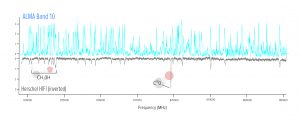
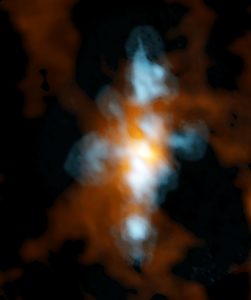
Heavy Water in NGC 6334I
Composite ALMA image of NGC 6334I, a star-forming region in the Cat’s Paw Nebula, taken with the Band 10 receivers, ALMA’s highest-frequency vision. The blue component is heavy water (HDO) streaming away from either a single protostar or a small cluster of protostars. The orange region is the “continuum emission” in the same region, which scientists found is extraordinarily rich in molecular fingerprints, including glycoaldehyde, the simplest sugar-related molecule.
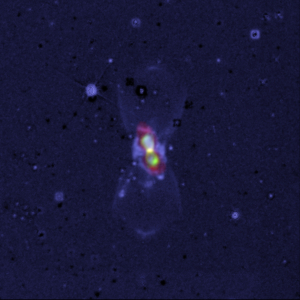
Pair of Colliding Stars Spill Radioactive Molecules into Space
A widefield, composite image of CK Vul, the remains of a double-star collision. This impact launched radioactive molecules into space, as seen in the orange double-lobe structure at the center. This is an ALMA image of 27-aluminum monofluoride, but the rare, radioactive isotopic version of AlF resides in the same region. The red, diffuse image is an ALMA image of the more extended dust in the region. The blue is optical hydrogen emission as seen by the Gemini observatory.

First Detection of Aluminium Nuclear Isotope in Space
Composite image of CK Vul, the remains of a double-star collision. This impact launched radioactive molecules into space, as seen in the orange double-lobe structure at the center. This is an ALMA image of 27-aluminum monofluoride, but the rare isotopic version of AlF resides in the same region. The red, diffuse image is an ALMA image of the more extended dust in the region. The blue is optical hydrogen emission as seen by the Gemini observatory.
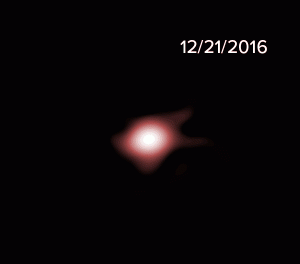
ALMA Creates Its First-ever Movie of Cosmic Explosion
ALMA’s time-lapse movie showing the “afterglow” of a powerful gamma-ray burst. These images of the millimeter-wavelength light reveal details about the energy in the GRB’s jets.
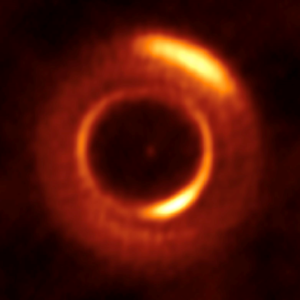
Spiral Arms and Dusty Clumps Seen in ‘Rare Breed’ of Protoplanetary Disk
Recent ALMA observations have reshaped our understanding of protoplanetary disks, the planet-forming regions around young stars. A striking new high-resolution image of MWC 758 — a young star about 500 light-years from Earth — reveal a dusty disk unlike any seen before. With its off-center cavity and sweeping spiral arms, MWC 758 may also provide new insights into the process of planet formation. “Our observations reveal a great amount of exciting new details in this system and provide crucial clues on their origins,” said Roubing Dong, a researcher with the University of Arizona and the Academia Sinica Institute of Astronomy and Astrophysics (ASIAA) in Taiwan.
The origin of these structures is in hot debate among astronomers. They may be the result of unseen planets forming in the disk or the large central cavities could be the outcome of radiation from the central star evaporating the inner disk.
Past observations of MWC 758 in 2012, as seen in reflected light, revealed a pair of near symmetric giant spiral arms. Earlier millimeter observations uncovered a big inner hole and two major dust clumps. The new ALMA image reveals that the previously known cavity of MWC 758 is off-center from the star and elliptical in shape. The millimeter dust emission feature corresponds nicely with one of the two spiral arms previously seen in reflected light. Both discoveries are the first among protoplanetary disks.
“MWC 758 is a rare breed!” says Sheng-Yuan Liu at ASIAA, “All major types of disk structures have been found in this system. It reveals to us one of the most comprehensive suites of evidence of planet formation in all protoplanetary disks.”
Photo Credit: ALMA (ESO/NAOJ/NRAO)/Dong et al.
Additional information
This research is presented in a paper “The Eccentric Cavity, Triple Rings, Two-Armed Spirals, and Double Clumps of the MWC 758 Disk” by Dong et al. to appear in the Astrophysical Journal.





